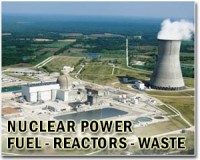 |
Los Alamos, NM (SPX) Apr 11, 2011 Advances made by researchers at Los Alamos National Laboratory could enhance the ability of scientists to develop advanced nuclear fuels in a safer, simpler manner. Uranium chemistry research relies heavily on a variety of uranium "starting materials"-solids and solutions-that are precursors to uranium compounds of oxygen, nitrogen, halogen, carbon, fluorine, and other elements, all of which are candidates for advanced nuclear fuels. Uranium also has been identified as a promising material in developing superconductors, and for use as catalysts-to speed up other chemical reactions. But uranium starting materials have traditionally been relatively difficult or hazardous to produce. Now researchers at Los Alamos National Laboratory have developed a method to produce uranium starting materials in a much more benign fashion. The method, recently published in the scientific journal Organometallics, relies on a room-temperature process that reacts uranium metal in a solution of 1,4-dioxane - a liquid organic solvent - and iodine. Conventional methods of producing uranium starting materials can require toxic chlorine-containing compounds and high temperatures or mercury iodide and low temperatures. Some of these syntheses are dangerous and generate a fair amount of waste. "A major barrier to widespread uranium chemistry research has been access to these starting materials," said Jaqueline Kiplinger, lead scientist on the research. "Easy access to uranium(III) and -(IV) precursors can change the way people do uranium work because there is less waste, and it's simpler, cleaner, safer, and faster." The synthesis involves placing readily available metal uranium shavings in a liquid bath of 1,4-dioxane and iodine at room temperature and stirring. The result is either UI3(1,4-dioxane)1.5 or UI4(1,4-dioxane)2, both called uranium iodides. Both waste little of the original uranium and are highly resistant to degradation. Further, these starting materials have been used to make many other uranium compounds that are valuable in uranium research. "It's my belief that these developments will open doors to a variety of new uranium research areas," said Kiplinger." In a recent edition of the magazine Chemistry World, Stephen Liddle, a uranium chemistry researcher in the United Kingdom, agreed. "Historically this area has lagged behind many others, and one reason is the lack of suitable precursor materials," he said. "Hopefully these alternative uranium halides will help open up the area in general by leading to new compounds." The research team includes Marisa Monreal, a Seaborg Graduate Student Fellow at Los Alamos, Robert Thomson and Nicholas Travia, both Seaborg Postdoctoral Fellows at Los Alamos, Thibault Cantat, Brian Scott and Jaqueline Kiplinger (all of materials physics and applications division). The research was supported by the DOE Office of Science-Heavy Element Chemistry program, the Los Alamos Laboratory Directed Research and Development program, and through Los Alamos National Laboratory Director's and G.T. Seaborg Institute for Transactinium Science Postdoctoral Fellowships. The Chemistry World article is available here. The Organometallics research paper is available here.
Share This Article With Planet Earth
Related Links Los Alamos National Laboratory Nuclear Power News - Nuclear Science, Nuclear Technology Powering The World in the 21st Century at Energy-Daily.com
 German nuclear companies halt environmental payments
German nuclear companies halt environmental paymentsBerlin (AFP) April 9, 2011 Four energy companies that run German nuclear plants said Saturday they have stopped payments to an environment fund after the government went back on its decision to keep the plants open for longer. EON, RWE and Vattenfall told AFP they stopped payment, starting this month, to the fund created in January as compensation for the government's decision last year to prolong the life of 17 nucle ... read more |
|
| The content herein, unless otherwise known to be public domain, are Copyright 1995-2010 - SpaceDaily. AFP and UPI Wire Stories are copyright Agence France-Presse and United Press International. ESA Portal Reports are copyright European Space Agency. All NASA sourced material is public domain. Additional copyrights may apply in whole or part to other bona fide parties. Advertising does not imply endorsement,agreement or approval of any opinions, statements or information provided by SpaceDaily on any Web page published or hosted by SpaceDaily. Privacy Statement |